Monday, March 10, 2008
Beijing, China, 2 Mar 2008: The Great Wall DIY
To Badaling By Public Bus
I was determined to visit the Great Wall on this, my third business trip to Beijing. Discouraged by horror tales of tours with time-wasting (and expensive) shopping stops, Joey and I decided (or rather I decided and Joey, suffering an impending flu attack and bravely battling the cold weather, reluctantly followed) to take the public bus to Badaling. It is possible, and in fact rather easy, to do-it-yourself. Here's how: 1. Take the subway to the Line 2 stop, Jishuitan (2RMB). Get out via exit B. 2. Either walk about 10 minutes to Deshengmen (you should be able to see this large fortified ancient gate structure, much like the Qianmen, in the distance) or take a short 3-minute 10RMB taxi ride (inform the driver you are going to Badaling). Ignore the modern bus terminus building along the way. 3. Join the queue for the large green and white long-distance 919 public bus. Check with the driver or conductor that the bus goes to Badaling (if necessary, print out the Chinese script 八达岭). Some 919 buses go only to Yanqing - a town just short of Badaling (why the bus company does not use another number is unfathomable). To add to the confusion, there are other city 919 buses that do not go to Badaling - these start from the afore-mentioned bus terminus. Ignore these. 4. There are express and regular 919 buses to Badaling. The former does not stop along the way, takes less than an hour for the journey, and are all scheduled to depart Deshengmen station before 1130h. The latter takes about 1.5 hours, making several stops along the way, but runs throughout the day. The fare should cost 12RMB on either bus. 5. The buses may depart from the bus bay behind Deshengmen, or from one across the road. Go up the bus to ask the driver or conductor. Do not worry if you miss the bus. There should be 2 or 3 departures every hour. 6. DO NOT BELIEVE ANYONE who tells you there are no more buses to Badaling. They are private bus or taxi touts who want to part you with your RMB. These cheats quote exorbitant fares (e.g. 80 RMB return on a bus). Sometimes, instead of Badaling, you may be brought to Juyongguan, a small Disney castle-like section of the Great Wall between Yanqing and Badaling, without the grand sweeping vista of the latter). Worse, the driver may demand more fare midway through the journey. DO NOT BELIEVE the officials at the information counter also (I suspect they are in on the conspiracy with the touts). BELIEVE ONLY the bus driver and/or conductor on the bus. 7. Be prepared for very crowded buses. It should not be a problem getting seats from Deshengmen, but the bus will be VERY packed on the return trip (at least until Yanqing) as the bus will have picked up passengers from stops farther than Badaling. 8. The last bus leaves Badaling station for Beijing at 1730h. Allow 2 to 3 hours for the Great Wall, and try to avoid rushing for the last bus. (I left Deshengmen at 1300h and returned by 1900h.) Again, DO NOT BELIEVE ANYONE who tells you there are no more buses back. The entrance fee for the Badaling Great Wall is 40RMB. It takes 2 to 3 hours to scale and descend from Haohancheng, the peak of the North Wall (880m above sea level, the 8th of 12 tower stations along this stretch). The South Wall is shorter but steeper in parts, and therefore less popular. While the Badaling Great Wall has been extensively reconstructed (unlike the raw wilderness at sections of the Great Wall at Simatai and Mutianyu), the grand expanse of the wall snaking up and down the surrounding rolling hills is nevertheless breathtaking. The ascent (and descent) requires considerable stamina. If fitness is an issue or time is limited, consider taking the cable car ride (40RMB singe or 60RMB return, last ride at 1600h) to the peak at the 8th station of the North Wall. The cable car entrance is different from the Great Wall entrance (about 1000m apart) - just follow the signs. There are more subway lines being built. By the Summer Olympic Games 2008, there should be a subway stop at the Badaling Express Bus Station (as well as another stop at the Summer Palace). Hopefully, the journey to Badaling will be less traumatic - if only they can clamp down on the scams. |
Labels: antiquity, architecture, Beijing, China, nature, transport, trekking
Sunday, March 09, 2008
Beijing, China, 29 Feb-2 Mar 2008: 老百姓
Common Folk
Less than 6 months to the Summer Olympic Games, Beijing is a hive of construction activities. In the Forbidden Palace, scaffoldings clad the 3 Great Halls, and modern slate tiles replaces uneven stone slabs gouged out from the ancient hallowed squares. Large parts of the traditonal Dazhalan quarters near Qianmen and hutongs adjacent to Wangfujing Street have been systematically torn down, their detritus shielded by giant billboards promising urban revitalization of meretricious appeal. The hoi polloi, 老百姓 Lao Bai Xing, soldier on bravely, immutable in the sea of change swirling around them. Guards at the Forbidden Palace shout at tourists who linger too long on the bridges leading to the south entrance. Hungry customers jostle to buy their lunch orders of steamed buns Xiao Long Bao. Intrepid office workers brave the jungle of commuters on the subway and public buses. Brusque security guards patrol the busy warrens of shops selling luxury knockoffs in the Silk Street Bazaar. Life goes on. Amid the rush, there is time for reflection. Monks and nuns take in the sights at the Forbidden Palace, sharing in lunchtime victuals on the benches outside Qianqinggong, the Inner Palace. In Beihai Park, enthusiasts huddle together and sing heartily to violin accompaniment on a crisp late winter Friday afternoon. A solitary man carefully wields a large water brush over the pavement, his ephemeral writing drying up and disappearing with the angled rays of the setting sun. |
Labels: Beijing, China, garden, lake, palace, people
Sunday, July 09, 2006
Beijing, China, 16-19 February 2006: Imperial Palaces
Forbidden Palace & Summer Palace, In Winter
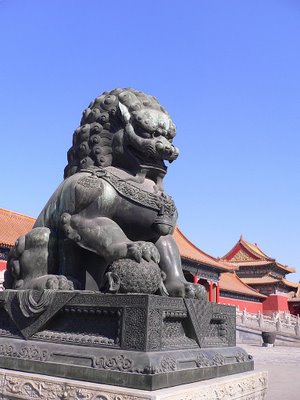 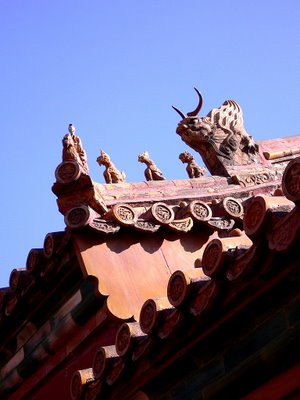 The Forbidden Palace was the seat of Qing dynastic rule for over 400 years. Guardian lions and fantastical rooftop beasts stand in perpetual vigil, casting magic protection over the Manchu emperor and his royal retinue. Emperor Qian Long reigned 60 years. His calligraphic inscription Zheng Da Guang Ming - Incorruptible Righteousness - hangs above his throne. 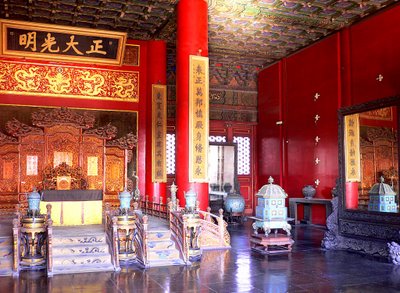 |
  Believed to ward off evil charms and spirits, auspicious red is everywhere. Palace walls and courtyard gates are coated in burnished crimson hues. Delicate ceramic tiles with recurring floral peony motifs adorn walls and columns. 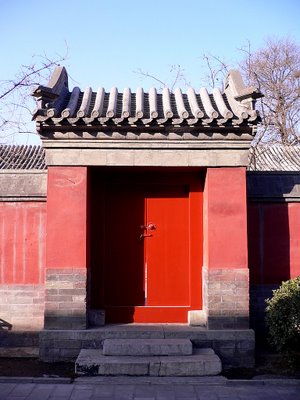 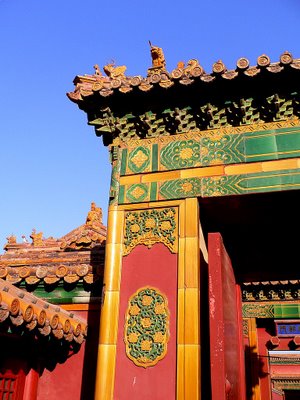 |
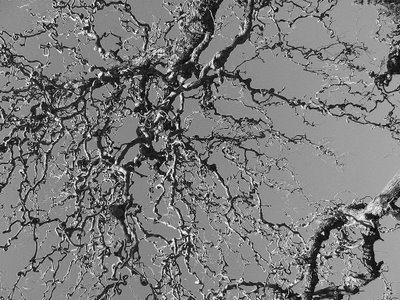 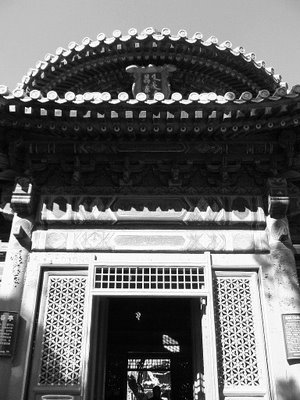 The Imperial Garden, behind the royal palaces, edges the northern palace wall. Within its compact compound, stylized rock sculptures, miniature pavilions and countless ornamental trees, centuries old, are meticulously laid out, no doubt after strict Feng Shui principles. |
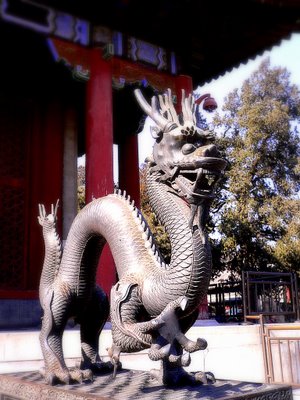 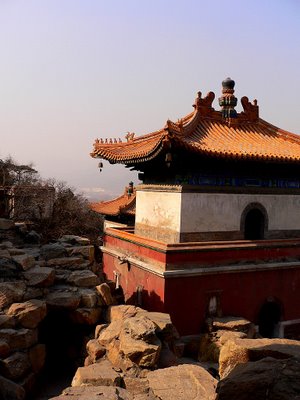 The Summer Palace, Yi He Yuan, was rebuilt following Western army ruination, using war funds expropriated by the infamous Empress Dowager Ci Xi. It became her summer Xanadu. Palaces were erected on Wan Shou Shan - Longevity Mount - and on the banks of Kunming Lake at its base. Temples built for imperial religious edification dot the landscape. Times have not been kind. Beheaded Buddha statues are scarred reminders of zealous cultural purification in the 60's. 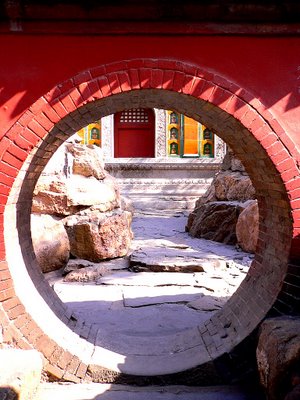  |
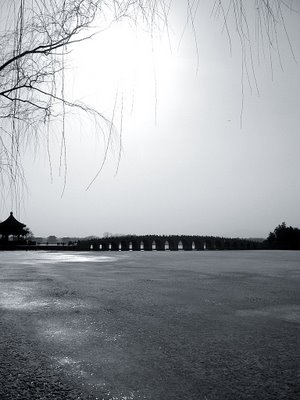 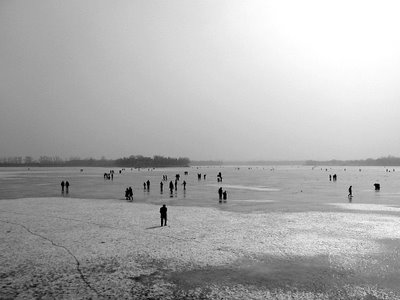  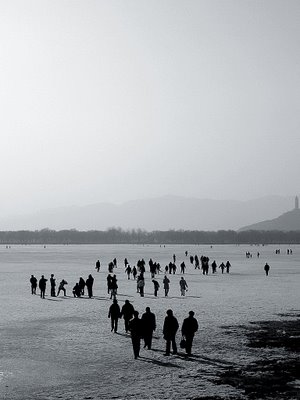 |
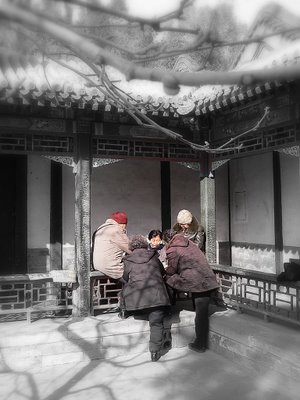 A long gallery Chang Lang connects the pavilions ringing Kunming Lake. Strolling, I chance upon these women playing cards. With impenetrable quiet concentration. |
Labels: Beijing, China, history, lake, palace, religious site

Licensed under Creative Commons Attribution-NonCommercial-NoDerivs 2.5 License

These are the 30 countries that I have ever set foot on. Airport stopovers don't count!
